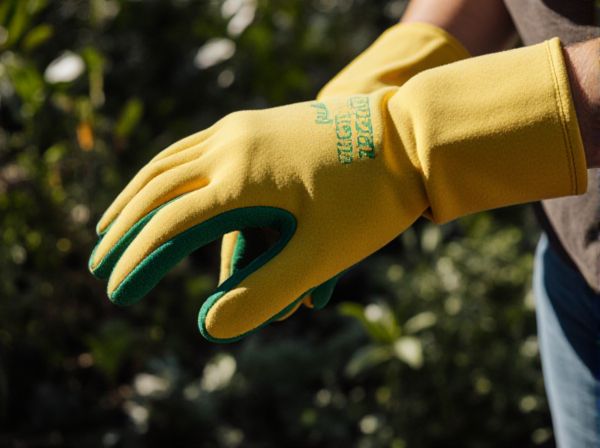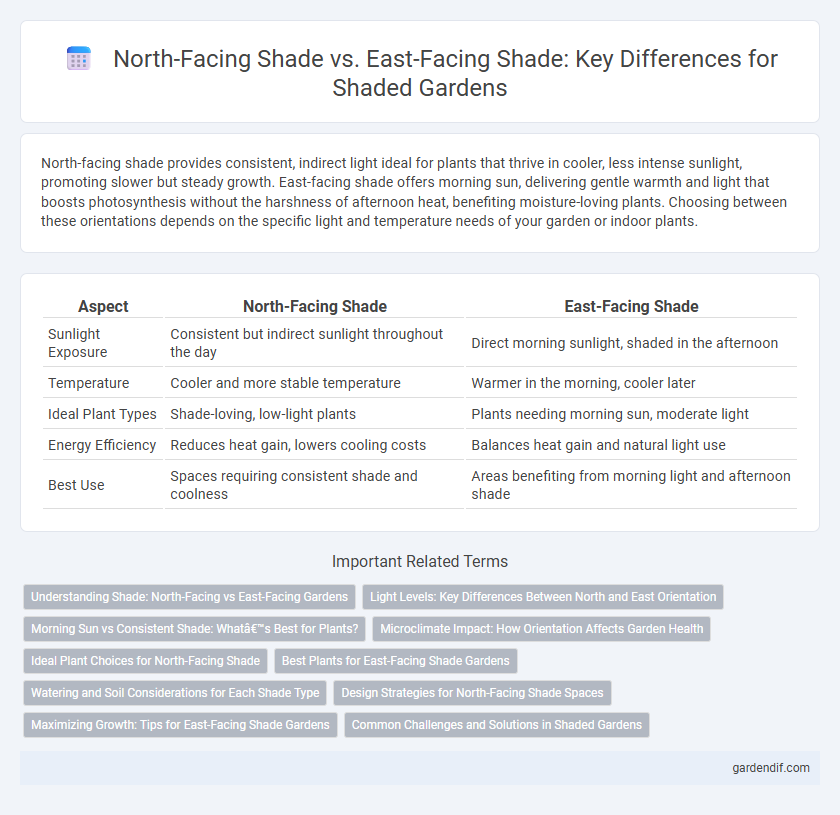
North-Facing Shade vs East-Facing Shade Illustration
North-facing shade provides consistent, indirect light ideal for plants that thrive in cooler, less intense sunlight, promoting slower but steady growth. East-facing shade offers morning sun, delivering gentle warmth and light that boosts photosynthesis without the harshness of afternoon heat, benefiting moisture-loving plants. Choosing between these orientations depends on the specific light and temperature needs of your garden or indoor plants.
Table of Comparison
| Aspect | North-Facing Shade | East-Facing Shade |
|---|---|---|
| Sunlight Exposure | Consistent but indirect sunlight throughout the day | Direct morning sunlight, shaded in the afternoon |
| Temperature | Cooler and more stable temperature | Warmer in the morning, cooler later |
| Ideal Plant Types | Shade-loving, low-light plants | Plants needing morning sun, moderate light |
| Energy Efficiency | Reduces heat gain, lowers cooling costs | Balances heat gain and natural light use |
| Best Use | Spaces requiring consistent shade and coolness | Areas benefiting from morning light and afternoon shade |
Understanding Shade: North-Facing vs East-Facing Gardens
North-facing gardens typically receive indirect, consistent shade throughout the day, making them ideal for shade-loving plants that thrive in lower light conditions. East-facing gardens get morning sunlight followed by afternoon shade, providing a balanced environment suitable for plants requiring partial sun and protection from intense afternoon heat. Understanding these light patterns helps optimize plant selection and garden design for healthier growth and aesthetic appeal.
Light Levels: Key Differences Between North and East Orientation
North-facing shade typically provides consistent, indirect light throughout the day, ideal for plants or spaces requiring moderate illumination without harsh sunlight. East-facing shade benefits from bright, direct morning light that tapers off by noon, promoting early-day warmth and energy while protecting from intense afternoon sun. The key difference lies in light intensity and duration, with north-facing areas receiving softer, steadier light and east-facing zones experiencing stronger but shorter light exposure.
Morning Sun vs Consistent Shade: What’s Best for Plants?
North-facing shade provides consistent, indirect light throughout the day, making it ideal for plants that thrive in low-light conditions and prefer to avoid direct sun exposure. East-facing shade offers exposure to gentle morning sun, which can benefit plants needing early light for photosynthesis without the harsh heat of afternoon sun. Choosing between the two depends on plant species' light preferences, with morning sun favoring plants requiring moderate light and north-facing shade suiting shade-loving varieties.
Microclimate Impact: How Orientation Affects Garden Health
North-facing shade creates a consistently cooler and moister microclimate, reducing sunlight exposure and slowing soil evaporation, which benefits shade-loving plants and moisture retention. East-facing shade receives morning sun, promoting moderate warmth while protecting plants from intense afternoon heat, aiding in controlled transpiration and reducing heat stress. Garden health is optimized by choosing plant species suited to these microclimate conditions, improving growth, disease resistance, and water use efficiency.
Ideal Plant Choices for North-Facing Shade
North-facing shade areas receive limited direct sunlight, making them ideal for shade-loving plants such as hostas, ferns, and astilbes that thrive in cooler, low-light conditions. These plants typically require moist, well-drained soil and can tolerate consistent shade, unlike sun-loving species that struggle with insufficient light. Incorporating native shade-tolerant plants enhances ecosystem compatibility while promoting healthy growth in north-facing garden spots.
Best Plants for East-Facing Shade Gardens
East-facing shade gardens receive gentle morning sunlight, making them ideal for shade-tolerant plants like hostas, ferns, and astilbes that thrive in filtered light and cooler temperatures. Compared to north-facing shade, which receives minimal direct sunlight, east-facing shade supports a wider variety of moisture-loving plants such as bleeding hearts and coral bells. Selecting plants suited for east-facing shade maximizes growth by balancing light exposure and protection from intense afternoon heat.
Watering and Soil Considerations for Each Shade Type
North-facing shade areas typically receive cooler, more consistent shade throughout the day, leading to slower soil drying and reduced watering needs compared to east-facing shade. East-facing shade gardens experience morning sun followed by afternoon shade, causing soil to dry more quickly and requiring more frequent watering to maintain optimal moisture levels. Soil in north-facing shaded spots often has higher moisture retention and less evaporation, while east-facing soils benefit from well-draining amendments to prevent waterlogging during morning sun exposure.
Design Strategies for North-Facing Shade Spaces
North-facing shade spaces benefit from design strategies that maximize natural light while minimizing cold drafts, making them ideal for plants that thrive in indirect light and cooler temperatures. Incorporating reflective surfaces and light-colored walls enhances brightness, while strategic placement of furniture near windows optimizes comfort without sacrificing warmth. Utilizing thermal mass materials can also regulate temperature fluctuations, ensuring a balanced indoor environment.
Maximizing Growth: Tips for East-Facing Shade Gardens
East-facing shade gardens benefit from morning sun exposure, promoting robust photosynthesis and healthy plant growth. Selecting shade-tolerant species like ferns, hostas, and impatiens maximizes foliage development in indirect light. Enhancing soil quality with organic compost and ensuring consistent moisture further supports vigorous growth in east-facing shaded environments.
Common Challenges and Solutions in Shaded Gardens
North-facing shade gardens often struggle with limited sunlight, resulting in slower plant growth and increased moisture, which can lead to fungal issues. East-facing shade provides morning sun that helps reduce dew and fungal problems but may still pose challenges for sun-loving plants due to afternoon shade. Solutions include choosing shade-tolerant species like ferns and hostas, improving soil drainage, and incorporating reflective surfaces or garden lighting to enhance light availability.
North-Facing Shade vs East-Facing Shade Infographic

 gardendif.com
gardendif.com